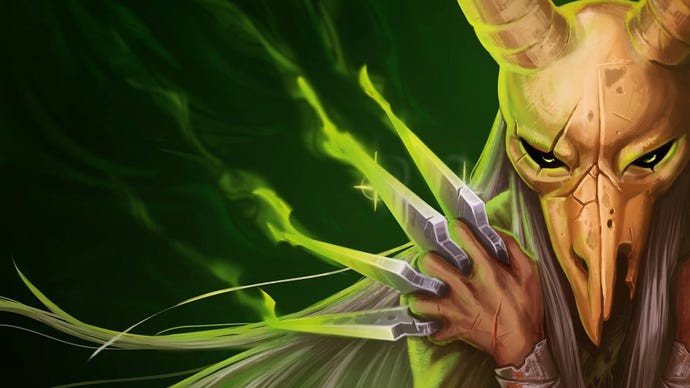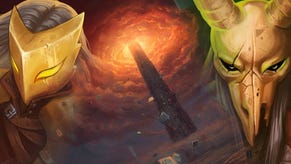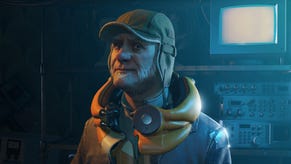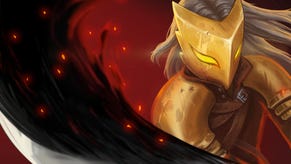Slay the Spire Review
One of the best indie games on PC makes its way to Switch. Our full review.
This article first appeared on USgamer, a partner publication of VG247. Some content, such as this article, has been migrated to VG247 for posterity after USgamer's closure - but it has not been edited or further vetted by the VG247 team.
Like most card games, Slay the Spire can be immensely enjoyable when hilariously overpowered. To wit, my first successful run came courtesy of a delightfully broken Ironclad deck featuring the Snecko Eye and Gambling Chip relics. All I could do was cackle as I threw down a huge number of powerful cards at once, easily outmuscling and eventually overwhelming my foes with near impenetrable armor and strength bonuses.
Such decks don't come along very often; but when they do, they're extremely satisfying. Most of the time you're scrambling for survival, desperately trying to keep your extremely finite pool of hitpoints up while searching for powerful cards and unique items with which to build your deck. There will be times when luck simply isn't on your side, resulting in cursing and eventually restarting. If you're really good, you might be able to dig yourself out of the hole you find yourself in and succeed. But every once in a while, everything will break right, and you'll be able to put an unholy smackdown on your enemies.
This is a large part of what makes Slay the Spire so enjoyable on Nintendo Switch. One part CCG, one part roguelite, Slay the Spire is built around slowly constructing a deck while steadily progressing through three separate acts. You begin with a few basic attack and defense cards, with your collection being built up through enemy encounters, shops, and random events. Relics earned along the way imbue your hand with unique effects, such as the ability to discard your opening hand. Many cards and relics will look powerful on their face, but if you don't build with a strategy in mind, you will be swiftly obliterated by monsters that can sometimes knock off half your life in one hit. And in Slay the Spire, death is permanent.
Avoiding an untimely end to your run takes a good deal of forethought and no small amount of luck. Even basic enemies can prove devastating if you're not careful. Some will pile on armor that's difficult to break, while others will overwhelm you with sheer numbers. One of the early bosses, in particular, a floating orb called the Hexaghost, will swiftly crush unprepared players with a bevy of fire attacks and damage-dealing burn cards. Suffice it to say, this is not a game you can brute force.
If you're not already steeped in the jargon and concepts of CCGs like Magic: The Gathering, this can make Slay the Spire feel overwhelming at first. I personally have a fair amount of experience with Hearthstone; but like most mere mortals, I relied on streamers and community sites for my winning strategies. I failed miserably at Slay the Spire to start, rarely making it past Act 1. But after a few successive runs, I was able to start developing a grasp of its metagame, finally culminating in my first victory. All of this is to say that Slay the Spire isn't just for experts—it can be extremely fun even if you're a relative CCG newbie like myself.
Of course, being a CCG, it's also subject to the genre's various foibles. Random chance has a large part to play in how hard or easy a given run can be, and some cards are so powerful that they're practically win buttons. This can make some runs feel doomed early if the right cards aren't coming in. Personally, I'm not a huge fan of leaving my chances of victory up to the RNG gods, but I suppose that top players would say that half the fun is learning to adapt to the poor hand you have been dealt. In any case, Slay the Spire's difficulty can be wildly variable depending on the relics and cards you find—either punishingly hard or hilariously easy.
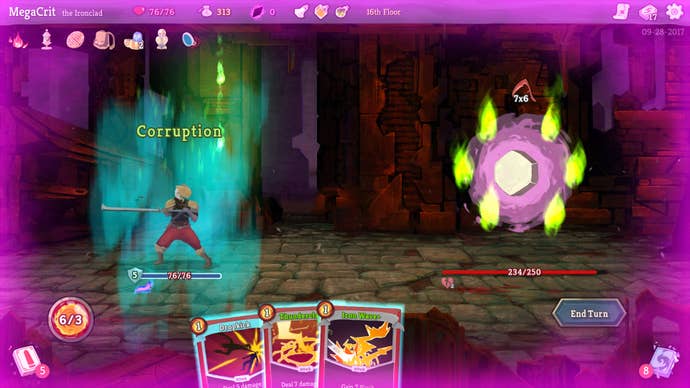
Regardless of these quirks, Slay the Spire has become what feels like a staple on my Switch in a relatively short period of time. It's completely drained my system's battery on a couple occasions now, which is generally a pretty decent indicator of how hooked I am on a game. I'll die; toss my Switch aside in frustration; ponder my card choices, then pick it up for another run. It's made all the more addictive by the inclusion of three distinct classes—the Ironclad, the Silent, and the Defect—all of whom have unique gameplay styles and cards. While the Ironclad brute forces foes, the Silent functions more as a rogue, encouraging you to build powerful combos while relying on damage over time. As for the Defect, they spawn different types of orbs, which can passively add armor or inflict damage, or be evoked for a burst effect. These differences make Slay the Spire less repetitive, forcing you to vary your approach and learn new styles, which is crucial in a game like this.
Upon the conclusion of your first successful run, Slay the Spire subsequently becomes a test of endurance. You will be able to progressively unlock difficulty levels called "Ascensions," the top levels being designed to challenge even the best players. This is where the competitive aspect of Slay the Spire comes in, as there are leaderboards and Daily Challenges available for those who want to keep playing well past the initial batch of levels.
All of this serves to make Slay the Spire a beautiful fit for Nintendo Switch in particular... assuming you're willing to overlook a few tech problems. On Switch, Slay the Spire will occasionally take a beat to load in cards, or encounters in general. It also crashed on me on two occasions, which appeared to reset the encounter that I was in. All of this happened while I was in handheld mode, so portable players take heed.
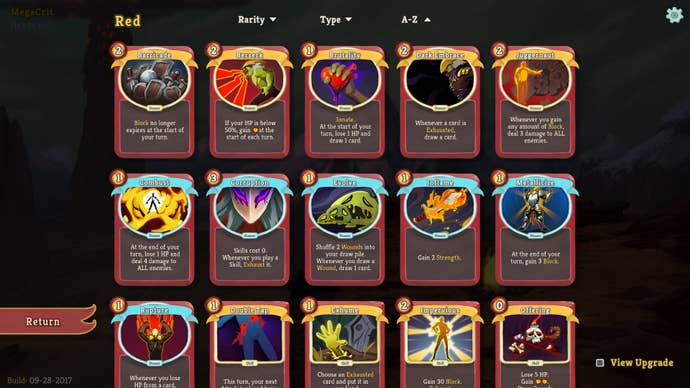
As the only portable version available though, at least until the iOS and Android version eventually gets announced (fingers crossed), Slay the Spire on Switch is terrific. It feels like it was made for long plane trips, or those moments where you're curled up on the couch playing a game while watching Friends on Netflix for the hundredth time. Experts, in particular, will find much to love in trying out underused cards and building unique decks. Like Diablo, it's one of those games that can remain fresh long after your initial playthrough.
With luck, Slay the Spire's developers will continue to support it well into the future. In particular, I think it could use at least another character or two, as the initial batch of three feels just a tiny bit slight (even if the characters themselves feel nicely fleshed out). But as foundations go, Slay the Spire could hardly be better. It's a marvelous addition to the Switch's lineup.
ConclusionSlay the Spire cleverly mixes the roguelite and card game genres, bringing with it a deep and satisfying strategy layer that encourages you to experiment over the course of a multitude of runs to the top of the tower. I can only hope that it continues to see regular updates, because it's already one of my favorite games of 2019.
